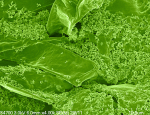From Discover Magazine:
Cultivating Safer Food Sources

Among the roots of a rice plant that grows in California, researchers detected a specific bacteria that attracts iron and forms a “shield” that blunts the plant’s uptake of toxic arsenic. Because rice grows underwater, it takes in 10 times more arsenic than other cereal grains such as wheat and corn. Arsenic occurs naturally but also is used in multiple industrial processes. Chronic exposure has been linked to cancer, heart disease and diabetes. This discovery could lead to a “probiotic” for rice plants in the form of either a coating on rice seeds or shots of the bacteria to immature plants. Such options may provide a natural, low-cost solution to the arsenic challenge facing rice crops around the world. Rice is a diet staple for more than half of the global population.
Protecting Life and Property

When Mother Nature wields her fury through natural disasters such as tornadoes, hurricanes and earthquakes, weather forecasters and emergency personnel alert local communities based on input they’ve received from event modeling and simulations. With the help of NSF funding, these technologies can now provide highly localized, real-time data. In the case of a tornado, simulations like the one pictured here provide forecasters with valuable information such as wind speed, air flow and pressure. The orange and blue wisps represent the rising and falling airflow around the tornado.